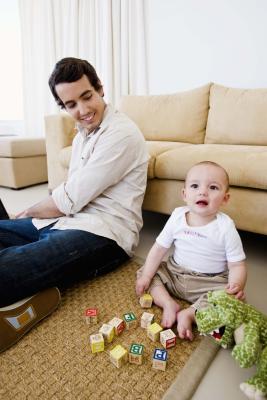During their first several years of life, babies learn not only how to handle their own emotions, but also how to read emotions of others. This emotional development occurs naturally and slowly, as the child becomes more in tune with the world around him and aware of stimuli in his environment. As your child moves through this developmental process, he will become even more responsive to you and aware of the world in which he lives.
Master Mimic
Long before your baby can understand, or perhaps even feel, his own emotions, he can mimic those that you feel. Babies begin their emotional development by replicating the look and tone of their parents and others around them, reports WebMD. While your child will initially not understand the facial expressions or sounds that he is replicating, he will eventually begin to comprehend the emotions that he is conveying.
Black and White
As Scholastic reports, babies are initially only able to distinguish two emotions, happy and sad. These undeveloped babies are unable to recognize the concept of shades of gray. It is for this reason that infants are often either smiling or screaming and can transition between the two with little effort. It is not until babies have developed their emotional maturity more keenly that they begin to recognize the concept of degrees when it comes to emotional stimulation.
Power of the Smile
One of the first signs of emotion that you can expect to see out of your growing infant is a smile. Many parents delight in this first smile, as it is a sign that the infant is feeling something. As Parents Magazine reports, eager moms and dads can expect to see this first smile by the time their infants reach 2 months old. While initially the infant will not recognize the fact that he is smiling, he will eventually gain control over this emotion conveying action. By 3 months old, you child will likely be able to smile to elicit attention, as he has learned that this simple action can capture the focus of his parents.
Coos and Cries
While infants exhibit their distress through crying almost from the moment that they come out of the womb, developing the ability to make sounds indicating happiness takes more time. As Parents Magazine reports, babies can often coo or indicate their happiness through sound creation by the time they reach 6 months of age.
Promoting Healthy Development
While much of the emotional development that your child will experience is natural and requires no input from you, you can help ensure that he develops properly by engaging in some simple activities. During the first several months of life, it is vital that you respond promptly when your child is upset. By doing so, you can show your child that he is safe and secure in your care. Also, engage in face-time with your baby regularly, making an assortment of facial expressions that he can mimic, allowing him to add these new looks to his collection of emotion-conveying expressions.





